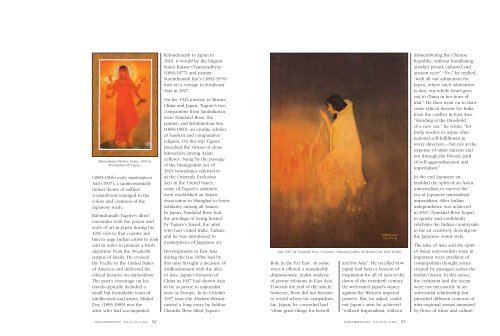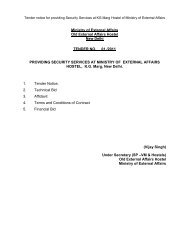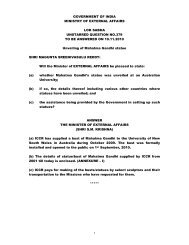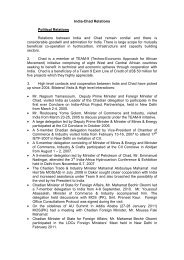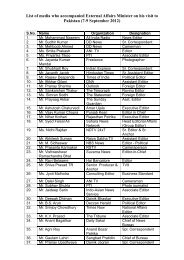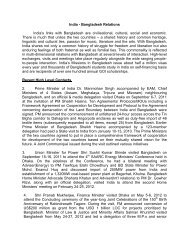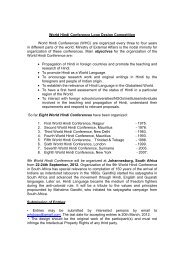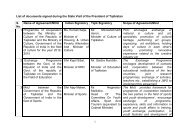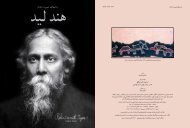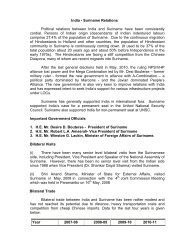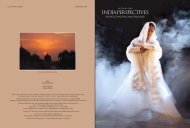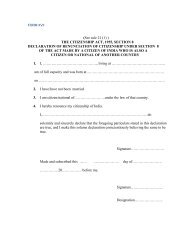IP_ Tagore Issue - Final.indd - high commission of india mauritius
IP_ Tagore Issue - Final.indd - high commission of india mauritius
IP_ Tagore Issue - Final.indd - high commission of india mauritius
Create successful ePaper yourself
Turn your PDF publications into a flip-book with our unique Google optimized e-Paper software.
Bharatmata (Mother India), 1905 byAbanindranath <strong>Tagore</strong>.(1883-1966) early masterpieceSati (1907), a quintessentiallyIndian theme <strong>of</strong> selflesswomanhood emerged in thecolors and contours <strong>of</strong> theJapanese wash.Rabindranath <strong>Tagore</strong>’s directencounter with the power andscale <strong>of</strong> art in Japan during his1916 visit to that country ledhim to urge Indian artists to lookeast in order to pioneer a freshdeparture from the Swadeshicorpus <strong>of</strong> ideals. He crossedthe Pacific to the United States<strong>of</strong> America and delivered hiscritical lectures on nationalism.The poet’s entourage on histravels typically included asmall but formidable team <strong>of</strong>intellectuals and artists. MukulDey (1895-1989) was theartist who had accompaniedRabindranath to Japan in1916; it would be the linguistSuniti Kumar Chattopadhyay(1890-1977) and painterSurendranath Kar’s (1892-1970)turn on a voyage to SoutheastAsia in 1927.On the 1924 journey to Burma,China and Japan, <strong>Tagore</strong>’s twocompanions from Santiniketanwere Nandalal Bose, thepainter, and Kshitimohan Sen(1880-1960), an erudite scholar<strong>of</strong> Sanskrit and comparativereligion. On this trip <strong>Tagore</strong>preached the virtues <strong>of</strong> closeinteraction among Asiancultures. Stung by the passage<strong>of</strong> the Immigration Act <strong>of</strong>1924 (sometimes referred toas the Orientals ExclusionAct) in the United States,some <strong>of</strong> <strong>Tagore</strong>’s admirerseven established an AsiaticAssociation in Shanghai to fostersolidarity among all Asians.In Japan, Nandalal Bose hadthe privilege <strong>of</strong> being hostedby <strong>Tagore</strong>’s friend, the artistwho had visited India, Taikan,and he was introduced tomasterpieces <strong>of</strong> Japanese art.Developments in East Asiaduring the late 1930s had bythis time brought a measure <strong>of</strong>disillusionment with the idea<strong>of</strong> Asia. Japan’s invasion <strong>of</strong>China in 1937 had shown Asiato be as prone to nationalistwars as Europe. In its October1937 issue the Modern Reviewcarried a long essay by SubhasChandra Bose titled ‘Japan’sSati, 1907 by Nandalal Bose. (Courtesy: National Gallery <strong>of</strong> Modern Art, New Delhi)Role in the Far East’. In someways it <strong>of</strong>fered a remarkablydispassionate, realist analysis<strong>of</strong> power relations in East Asia.Towards the end <strong>of</strong> the article,however, Bose did not hesitateto reveal where his sympathieslay. Japan, he conceded had“done great things for herselfand for Asia”. He recalled howJapan had been a beacon <strong>of</strong>inspiration for all <strong>of</strong> Asia at thedawn <strong>of</strong> the twentieth century.He welcomed Japan’s stanceagainst the Western imperialpowers. But, he asked, couldnot Japan’s aims be achieved“without Imperialism, withoutdismembering the ChineseRepublic, without humiliatinganother proud, cultured andancient race?” “No,” he replied,“with all our admiration forJapan, where such admirationis due, our whole heart goesout to China in her hour <strong>of</strong>trial.” He then went on to drawsome ethical lessons for Indiafrom the conflict in East Asia.“Standing at the threshold<strong>of</strong> a new era,” he wrote, “letIndia resolve to aspire afternational self-fulfillment inevery direction – but not at theexpense <strong>of</strong> other nations andnot through the bloody path<strong>of</strong> self-aggrandisement andimperialism.”In the end Japanese artenabled the spirit <strong>of</strong> an Asianuniversalism to survive theera <strong>of</strong> Japanese nationalisticimperialism. After Indianindependence was achievedin 1947, Nandalal Bose beganto quietly and confidentlycelebrate the Indian countrysidein his art creatively drawing onthe Japanese sumie style.The idea <strong>of</strong> Asia and the spirit<strong>of</strong> Asian universalism were inimportant ways products <strong>of</strong>cosmopolitan thought zonescreated by passages across theIndian Ocean. In this sense,the continent and the oceanwere not necessarily in anadversarial relationship butprovided different contours <strong>of</strong>inter-regional arenas animatedby flows <strong>of</strong> ideas and culture.INDIA PERSPECTIVES VOL 24 NO. 2/2010 92 INDIA PERSPECTIVES VOL 24 NO. 2/2010 93


